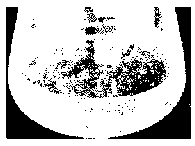Germplasm test tube storage and ex-situ conservation method for East Asian phyllitis japonica
A preservation method and germplasm technology, applied in horticultural methods, botanical equipment and methods, horticulture, etc., can solve problems such as scarcity of reserves, degradation of varieties, damage to fragile ecological environment, etc.
- Summary
- Abstract
- Description
- Claims
- Application Information
AI Technical Summary
Problems solved by technology
Method used
Image
Examples
Embodiment 1
[0028] Example 1 Spore Germination
[0029] The material comes from the forest area of Baishan City, Jilin Province; the sporophyll containing mature sporangia is taken, and the sporophyll is cut into 1 cm in size in the laboratory; 0.1% HgCl under sterile conditions 2 The solution was sterilized for 5 minutes, rinsed with sterile water 6 times, blotted dry with filter paper and inoculated.
[0030] Inoculation method: There are three methods of inoculation, one is direct inoculation of sporophylls; the other is inoculation after stripping the sporangia in the sporophylls under the dissecting microscope of the ultra-clean workbench; On the filter paper with the size of 2cm × 2cm after bacteria, carefully crush the sporangia with a scalpel, release the spores in it, and inoculate together with the small filter paper.
[0031] Spore culture: Two methods of solid culture and liquid culture of 1 / 2MS+20g of sucrose were adopted.
[0032] Culture conditions : 12h / d under...
Embodiment 2
[0035] Example 2 Prothallus Subculture and Proliferation
[0036] Cut the prothallus formed after spore germination into small pieces of about 0.5 cm in size, each small piece contains about 5-10 pieces of prothallus, and inoculate them into solid MS medium containing different concentrations of plant growth regulators (See Table 1), inoculate 8-10 pieces per bottle.
[0037] The protophyll mass formed after spore germination was respectively inoculated into MS medium containing different concentrations of plant growth regulators, culture conditions: 100-200lx scattered light, light 12h / d. The daytime temperature is 25-26°C, and the nighttime is 20-22°C, which is the same as the spore germination condition; after 60 days, observe the proliferation and growth of the prothallus (see Table 1, Image 6 , Figure 7 ).
[0038] Prothallus can proliferate at a rate of about 5 times in several media tested. The new multiple range test showed that there was no significant diffe...
Embodiment 3
[0040] Embodiment 3 prothallus test tube preservation
[0041] will grow robust prothalloids ( Image 6 ) placed in a light incubator. The culture temperature is 10, 12, 14, 15, 16, and 17°C; the light is 5-7h / d; the light intensity is 200-300lx; the medium is 1 / 2MS+sucrose 25-30g / L, or MS+sucrose 25-30g / L of solid medium; once every 12 months, a part of the prothallus was kept for preservation and culture during each transfer, a part was transferred to normal culture conditions for proliferation and subculture treatment, and a part was used for sporophyte induction outside the test tube. Observe its subculture proliferation and sporophyte plant formation.
[0042]After the prothallus were cultured at 14, 15, and 16°C for 12 months, there was almost no growth and proliferation, and the state was similar to that at the beginning of the culture. After being transferred to subculture conditions, it can still proliferate and grow normally; After 60 days of cultivation, the v...
PUM
 Login to View More
Login to View More Abstract
Description
Claims
Application Information
 Login to View More
Login to View More - R&D
- Intellectual Property
- Life Sciences
- Materials
- Tech Scout
- Unparalleled Data Quality
- Higher Quality Content
- 60% Fewer Hallucinations
Browse by: Latest US Patents, China's latest patents, Technical Efficacy Thesaurus, Application Domain, Technology Topic, Popular Technical Reports.
© 2025 PatSnap. All rights reserved.Legal|Privacy policy|Modern Slavery Act Transparency Statement|Sitemap|About US| Contact US: help@patsnap.com



